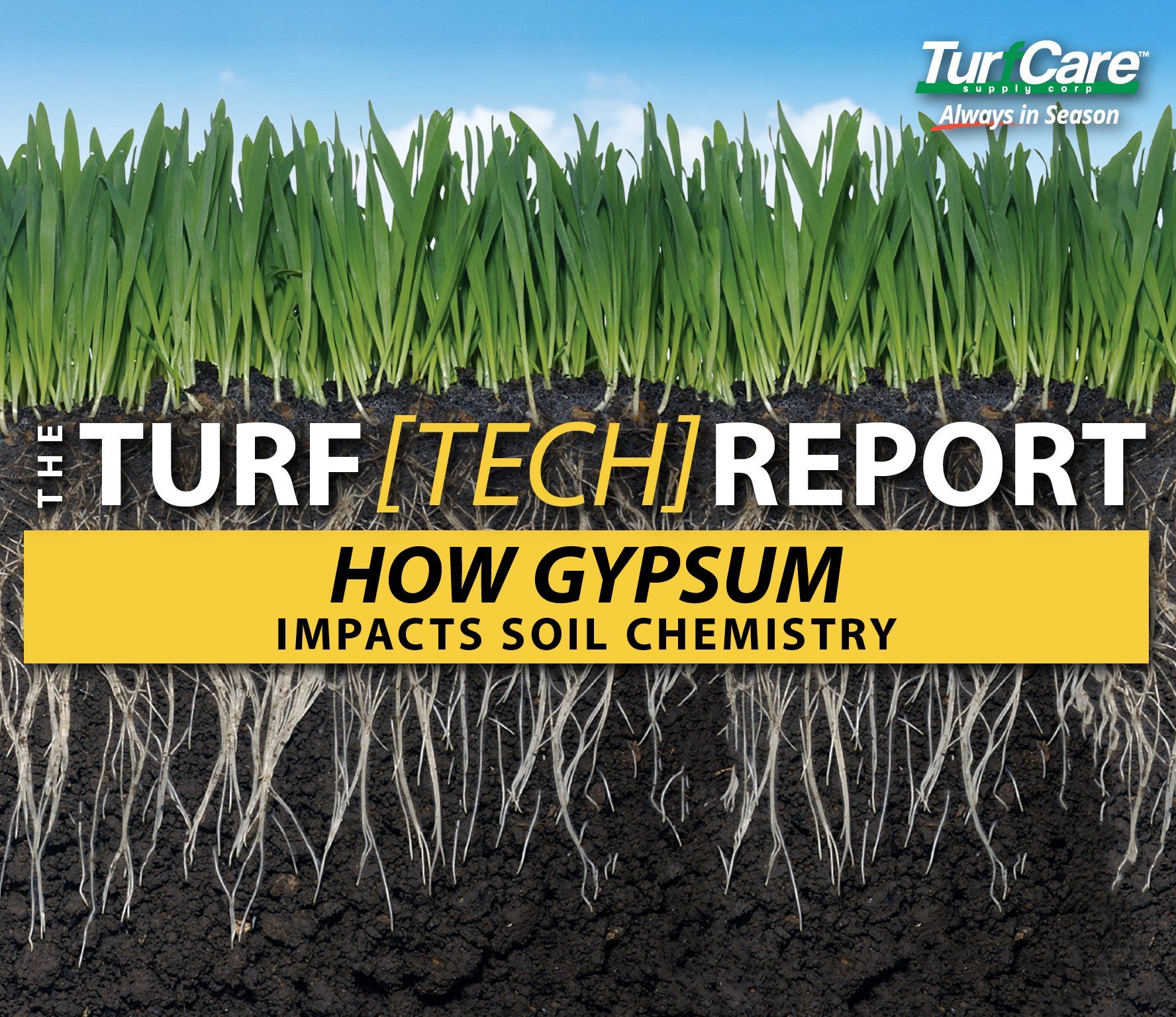The Turf[TECH]Report - How Gypsum Impacts Soil Chemistry

The use of gypsum as a soil amendment has been around for more than 250 years due to its many characteristics that help soil chemistry. Soil amendments , like gypsum, are undervalued in comparison to fertilizer usage, but the bottom line is it will not matter the amount of fertilizer applied to a lawn, the plants will not be able to access key nutrients essential for growth if the soil is compacted or the chemistry is compromised. But why gypsum? Let’s take a look into what gypsum is and its benefits to soil as well as when and why applying it to your lawn can improve turf health, appearance and the efficiency of nutrient uptake.
BUT WAIT! WHAT IS GYPSUM?
Pelletized Gypsum (calcium sulfate) removes sodium in soil and replaces it with calcium and sulfur, which are essential macronutrients not typically applied during fertilization which help boost plant health. Gypsum works great at loosening compact clay soil by pulling particles together creating porous spaces for air, water and plant roots. Gypsum also increases water storage and reduces erosion. This amendment is great for any soil type since it will improve soil structure while not altering pH. Gypsum is a moderately, soluble source, that performs in all three categories of soil treatment: a conditioner, a nutrient provider and an amendment.
- TIP: Gypsum is a perfect soil amendment to use against salt damage from winter.
Conditioner
Gypsum improves compacted soil by breaking it up, increasing water infiltration rates, reducing erosion losses of important plant nutrients as well as soluble phosphorus water run-off.
Nutrient provider
No, gypsum is not a true fertilizer that provides needed N-P-K levels for plants, but rather helps plants by introducing calcium and sulfur, essential macronutrients not typically applied during normal fertilization methods, to help soil perform better by enhancing nutrient availability and improving soil structure. Gypsum also improves utilization of calcium, magnesium, potassium and other cations difficult to consume from the soil.
Amendment
Gypsum amends soil aggregation by preventing dispersion of soil particles, reducing surface crust formation and compaction; promoting deep rooting and seeding emergence as well as amending sodic soil reclamation.
WHY APPLY GYPSUM?
Fertilizing is just not enough when preparing and managing a lawn’s health. Although fertilizer helps put needed macronutrients like Nitrogen , Phosphorus and Potassium back into soil for plant uptake, soil amendments like gypsum are necessary to make the nutrients you apply available to the plant as well as adding critical macronutrients to your soil.
BENEFITS OF GYPSUM
- Replenishes calcium and sulfur which are essential macronutrients not typically applied during fertilization
- Can be used on all soil types, improves soil structure but will not alter pH
- Reduces compacted clay soils allowing nutrients and water to be accessible to the plant
- Removes sodium (salt toxicity, great for ice melt damage and coastal areas)
- Assists in temperature and drought hardiness
- Increases water storage and reduces erosion
HOW DO I KNOW I NEED GYPSUM?
If your soil is compacted, deficient in calcium and sulfur, or suffering from salt toxicity, gypsum is the solution for you. A soil test is recommended in order to better understand macronutrient deficiencies, base saturation levels (percentage of nutrient holding sites occupied by cation ), as well as, soil salt toxicity and overall soil chemistry. Testing the soil is also helpful when applying gypsum applications in order to determine appropriate rates of application. Review all label instruction before applying.
- NOTE: When looking at soil test results, you want the soil’s target saturation levels for the macronutrients Calcium to be: 70-80% and for Magnesium to be: 10-13%.
WHEN CAN I APPLY IT?
Since Gypsum can be used on any soil type because it does not alter the soil pH level, you don’t have to balance your pH level before applying. Also, since Gypsum is not a fertilizer, it can be used before or after a fertilizer application, anytime of the season.
WHAT PRODUCT SHOULD I USE?
TurfCare™ has a great gypsum product that gets the results you need and more! They offer an enhanced pelletized Gypsum product powered by AMP-XC™ with Humic and Iron. This enhanced product includes not only Gypsum, but also a protein hydrolysate (AMP-XC™), concentrated organic materials (Humic) and the most important element involved in greening (Iron). This powerful combination of ingredients activates the benefits of gypsum along with several beneficial biological and environmental responses in the plant and soil and greatly improves the health and lush green appearance of turf.
JARGON
- Cation Exchange Capacity (CEC): The measurement of the soil’s ability to hold positively charged ions, influencing soil structure stability, nutrient availability, soil pH and reaction to fertilizers as well as other ameliorants.
- Sodicity: the amount of sodium held in a soil; sodium is a cation (positive ion) that is held loosely on clay particles in soil. When sodium makes up more than about 5% of all cations bound to clay particles, structural problems begin to occur, and the soil is said to be sodic (Chapter D5. Sodic soil management, nsw.gov)
For professional fertilizers, humic and AMP-XC™ enriched products available, please visit TurfCare’s online Product Catalog.
For green industry professionals or others interested in ordering Turfcare products, please contact our Customer Service to find a distributor near you.
The TURFReport Highlights:
Additional Articles and Insights
















